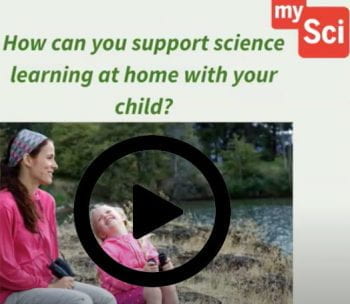Lead Instructional Specialist Jeanne Norris shares advice on how families can support science learning at home.
Video: supporting at-home science learning


Lead Instructional Specialist Jeanne Norris shares advice on how families can support science learning at home.
Explore how plants and animals respond to their surroundings. Activities: Observe and record how a pet or wild animal’s behavior changes for as long as you can. https://www.sciencebuddies.org/science-fair-projects/project-ideas/experiment-with-animal-behavior Play a ruler drop game. See how long it takes for you to catch a ruler between your fingers. https://www.education.com/science-fair/article/biology_oops/ Video and Readings: Videos: Home Sweet Habitat […]
Activity: Have you ever noticed that sunlight makes colors fade? Gather brightly colored paper, several pennies or other shapes like legos or building blocks. Find a spot outside that gets several hours of sunlight and arrange them to form a pattern or design. Wait 4-6 hours and then remove the pennies or blocks and observe […]
Activity: Using a packet of mixed wildflower seeds or bird seed, ask your child to sort the seeds by properties they observe. Maybe they can sort the seeds by size, by color, or by shape. Count how many different kinds of seeds there are. Safety Tip: Some seeds can be eaten, like sunflower seeds, but all […]
Explore the interactions of living (plants, animals) and nonliving (water, light and air) parts of the environment. Then think about what living things need to grow. Activities: If you have dry beans at your house, soak them and see if they sprout. See if they can grow without air, without water, without light, or without […]
Activity: Using a mason jar with a lid, boiling water, a little hairspray and some ice cubes you can make a cloud in a jar. First boil about 1/3 cup of water and add it to the jar. Quickly spritz a bit of hairspray in the jar and add the lid upside down to the […]
Explore the similarities and differences of life cycles of plants and animals. Activities: Grow a plant from seed and watch its life cycle from birth, to growth, to seed production, to death. Observe plants around your house or neighborhood in different life cycle stages. Draw realistic pictures of what you see. Label your drawing. https://www.pbslearningmedia.org/resource/tdc02.sci.life.colt.lp_plantcycle/plant-life-cyclesGo […]
How do plants and animals interact? How do ecosystems change over time? Activities: Make a list of the living and nonliving things in your yard or neighborhood. Use the free iNaturalist app to identify the kinds of plants and animals in your yard or neighborhood. Try to make a food chain from things you find, […]
Information and Updates (March 24) Note to mySci Partners – Units at a Glance (March 20) Email from ISP’s Executive Director on COVID-19
